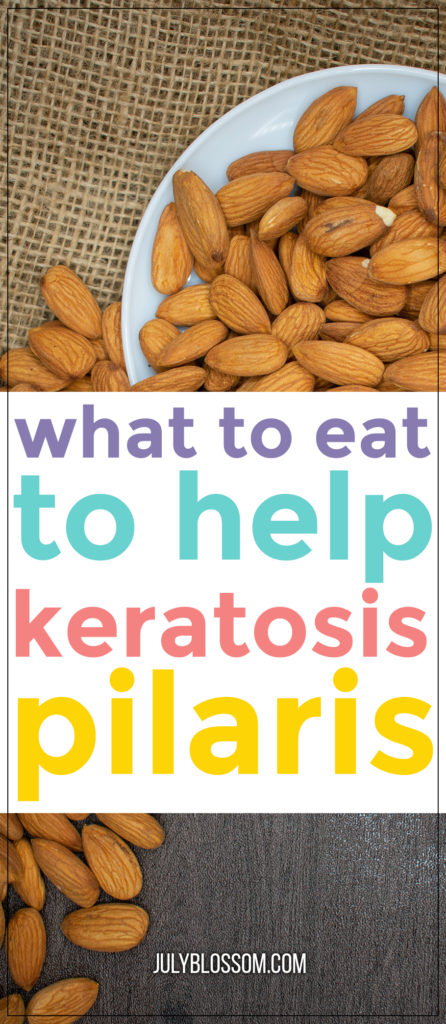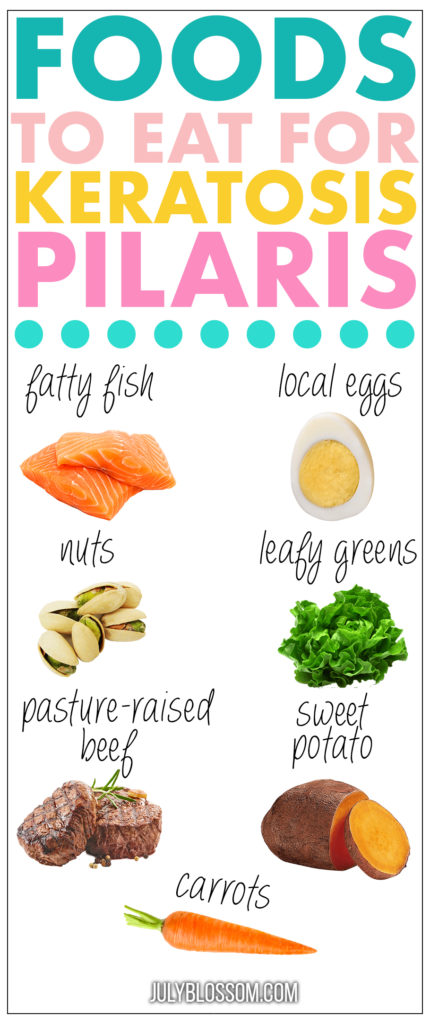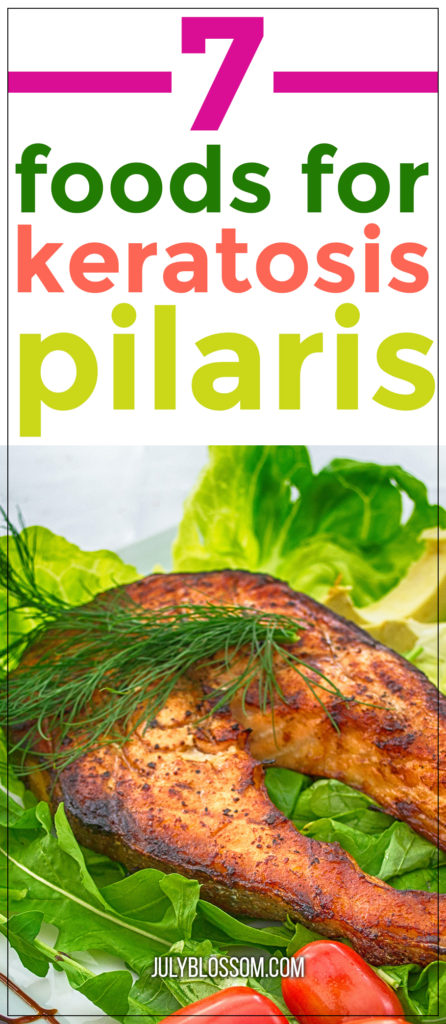There’s so much talk on foods to avoid when you have keratosis pilaris. But what about the safe and beneficial foods to eat with keratosis pilaris? That’s what this article talks about so read on!
We know KP is not something easy to deal with. You can feel self-conscious to wear certain clothes that show skin or you may have to eliminate certain favorite foods. The good thing is, keratosis pilaris doesn’t have to stick around forever.
You CAN help it go away by taking some action. One of the ways is to load up your plate with some nutritious foods such as:
7 Foods to Eat with Keratosis Pilaris

1. Oily Fish
Oily fish is also known as fatty fish. They include sardine, salmon, anchovies, mackerel and more.
It’s the omega 3 fatty acids and Vitamin D content that make oily fish one of the best foods to eat with keratosis pilaris.
Omega 3 is very important when it comes to keeping skin healthy.
Many people have seen improvement for inflammatory skin conditions like eczema, psoriasis and rosacea as well as acne and keratosis pilaris as well.
It helps fight inflammation and keeps skin smooth and soft.
2. Sweet Potatoes
Rich in Vitamin A, these starchy delicious roots are also great for keeping keratosis pilaris in check.
Vitamin A deficiency is said to be one of the causes of KP so there’s no harm in adding good servings of sweet potatoes into your diet.
Vitamin A is a fat-soluble vitamin, which makes it an important nutrient for the skin in particular. It prevents against dry skin which also comes with keratosis pilaris.
3. Nuts
Munch on those nuts because these crunchy goodies are also good for KP skin!
Nuts like almonds, pistachios, cashews and brazil nuts among others contain high amounts of Vitamin E.
Vitamin E is #1 when it comes to beauty purposes. It keeps skin plump with moisture, smooth with no fine lines and soft like a baby’s skin.
Another nutrient that nuts are rich in is zinc. Zinc is well known to help fight acne but it also keeps with KP as well!
Zinc helps maintain moisture levels in skin and also prevents and treats the pus-filled bumps and plugs KP tends to cause.
4. Leafy Greens
What’s a complete diet without leafy greens?
Some common leafy greens are spinach, kale, dandelion greens, collard greens, lettuce, Swiss chard and more.
They contain high levels of nutrients that protect and preserve the skin. These nutrients include iron, calcium, Vitamin A, Vitamin E, Vitamin C, Vitamin K, magnesium, zinc and others.
Calcium is needed for alleviating dry skin, which is a symptom of KP.
The Vitamin K in leafy greens is also useful for KP. It is fat soluble and can help improve blood circulation which in turn reduces skin inflammation, swelling and redness. This vitamin also helps speed up skin repair and healing.

5. Free Range Eggs
Focus on consuming free range or local eggs in your diet. Avoid factory eggs as these contain hormones in them and the hens are fed a limited diet of corn and soy.
Eggs are important in a keratosis pilaris diet because they contain omega 3 fatty acids, great for combating inflammation as we saw above.
The yolks also contain Vitamin D that most people don’t get enough. As we saw above, Vitamin D is vital for healthy skin.
6. Pasture Raised Beef
Pasture raised beef also contains omega 3 fatty acids, which helps calm inflammation in skin.
But what makes pasture raised beef special is that it has a perfect omega 3 to omega 6 ratio of 1:1.
Most of us consume a lot of omega 6 fatty acids because the processed foods we eat, including factory farmed meats, have a lot of it due to preservatives, hormones, and other artificial additives.
This makes the ratio of omega 6 to omega 3 fatty acids very skewed.
So ensure to eat lots of omega 3 fatty acids in your diet, including pasture raised beef, to balance out the omega 6: omega 3 ratio and keep your body & skin healthy.
If you can’t, maybe you can try an omega 3 supplement.
7. Carrots
What’s a vegetable that contains a boat load of beta carotene? Carrots, of course!
Beta carotene is a phytonutrient that gives carrots their deep orange color. It is converted to Vitamin A in our bodies.
Deficiency of Vitamin A results in dry, flaky and rough skin and guess what? Keratosis pilaris is dry flaky and rough skin!
Vitamin A can help preserve moisture in your skin preventing it from getting dehydrated, which can also help minimize itching, if your KP itches like mine does!
8. Bonus Superfood: Bone Broth for Keratosis Pilaris

You have reached the end of the article, ‘Foods to eat with keratosis pilaris.’ Thanks for reading and I wish you smooth bump-free skin!
Leave a Reply